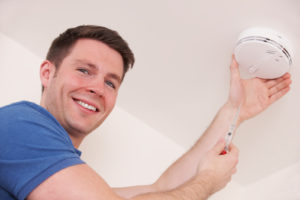Stay Safe With the Right Carbon Monoxide Alarm
 Choosing a Carbon Monoxide (CO) Alarm:
Choosing a Carbon Monoxide (CO) Alarm:
The U.S. Consumer Product Safety Commission cites “Carbon monoxide as the leading cause of gas poisoning death in the U.S.” “Thousands of cases of illness and death could be prevented if all residents had CO detectors,” notes Iowa State University (ISU) Professor Dr. Thomas Greiner in an ISU Extension Publication.
That same publication provides a wealth of helpful information on how to select and use a carbon monoxide detector. Among the highlights:
• Choose a detector listed with Underwriters Laboratory (UL).
• Both battery and AC powered detectors have advantages. The battery-operated detector is easy to install and move, and operates during power outages when emergency heating systems may be use.
• A plug-in detector does not depend on a battery and does not require battery and sensor replacement.
• AC line powered detectors with a battery pack also are available at a slightly higher cost.
• Detectors that are wired together offer the most protection because they will all sound when CO is detected by any detector.
Installing Carbon Monoxide Alarms
Once you decide which type of detectors to buy, you will need to consider where to install them. Most experts recommend placing a carbon monoxide detector close to all sleeping areas so they will awaken anyone who may be asleep when CO levels reach a dangerous level.
The National Fire Protection Association (NFPA) advises placing a CO alarm on every level of the home and in other locations where required by applicable laws, codes, or standards. In Minnesota residences, a CO alarm is required within 10 feet of each room used for sleeping.
Dr. Greiner of ISU also recommends locating additional detectors near fossil fuel appliances, but “at least 15 feet from the furnace, water heating or cooking appliances.” He urges “not mounting them in dusty, dirty or greasy areas, or in extremely humid areas.”
For best results, read and follow the directions provided with your new carbon monoxide detectors. You can also purchase one during a routine maintenance visit from a Standard Heating technician.
Once your detectors are installed, make sure to check that they are working on a monthly, or even weekly, basis. Keep them clean, dust-free and supplied with working batteries when applicable.
What to do if your detector sounds off?
The NFPA advises “immediately moving to a fresh air location outdoors or near an open window or door. Make sure everyone inside the home is accounted for. Call for help from a fresh air location and stay there until emergency personnel arrive (and do not return until you get the ‘all clear’ from emergency responders).”
Plan ahead by contacting your local fire department’s non-emergency number to ask for the proper number to call if the CO alarm sounds. Keep the number clearly posted by your detectors and in your cell phone contact directory. If you don’t know where to call, call 9-1-1.
The Consumer Products Safety Commission says “never ignore a carbon monoxide alarm. . . it is warning of you a potentially deadly hazard.” We could not agree more!
Find the Source of Carbon Monoxide
Once the immediate threat has passed, do not become complacent. Dr. Greiner from Iowa State University recommends always getting to the cause of your alarm going off. This is where Wulf Brothers professionals can be of particular help to you.
“Find out what caused the alarm,” advises Dr. Greiner. “Contact your heating contractor for help in tracking down the CO source. Determine why the CO remained in the house versus venting outside…Be persistent…Carbon monoxide causes confusion, irrational thinking, memory loss, and fatigue. The detector will alarm before these symptoms occur. It is important to respond to the alarm before continued exposure disables occupants.”
Wulf Brothers hopes these posts on carbon monoxide safety will help ensure that you and your family remain safe and healthy throughout the year. Please do not hesitate to call us for help in servicing your heating and cooling equipment, determining CO levels present in your home, or helping to identify the source of carbon monoxide in your home.
Wulf Brothers: At your door when you need us!
